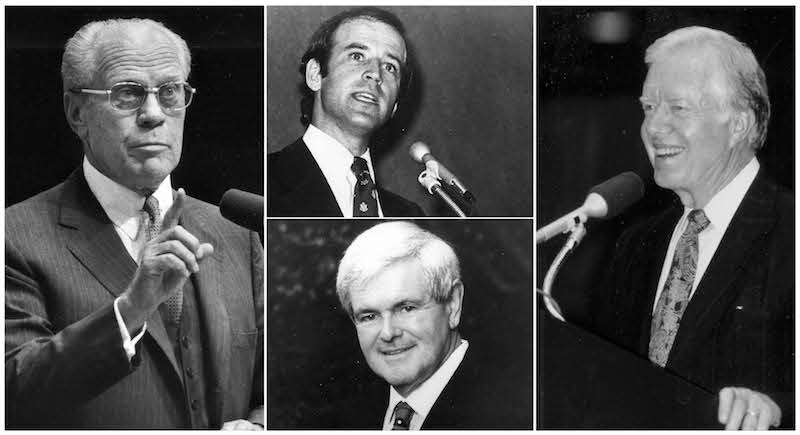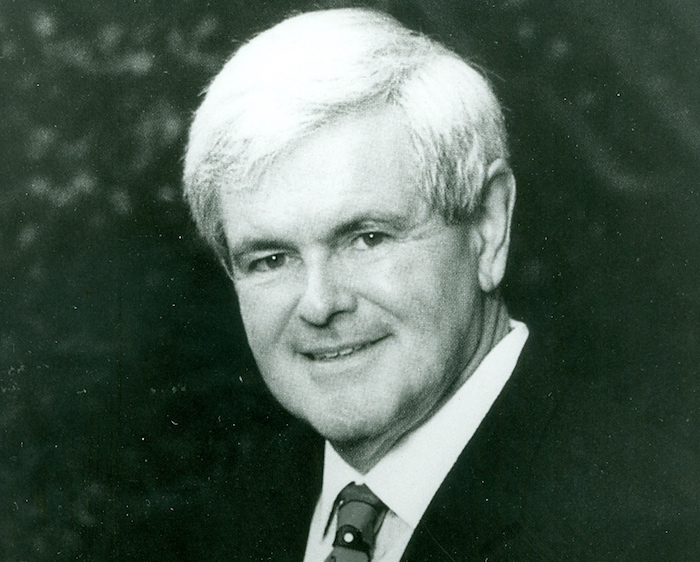University Libraries

Politicians on Campus: A Look Back
By Garrett Reese '21
In the early 1970s, the University of Dayton started the Distinguished Speakers Series to bring some of the biggest and influential names to campus to discuss the issues of the day. In the pamphlet released for the first series during the 1974-75 academic year, the University Activities Office described the Distinguished Speakers Series as being “designed to bring permanent persons who make or influence the big decisions that all of us must live with.” The series would bring some of the biggest names of the 20th century to UD’s campus over the following decades — artists, directors, authors and, as this blog post illustrates, politicians.
It seems fitting, with this week’s presidential election, to gaze backward to see what big-named politicians have visited the University of Dayton over the years.
On Nov. 4, 1976, Sen. Joseph R. Biden Jr. came to the University of Dayton. In 2020, we have a very particular image of Biden — that of the man of 77. At that time, however, today’s presidential candidate and former vice president was 33. In fact, Biden had only been elected to the Senate in 1972 at the age of 29, making him one of the youngest people elected to the position. Far from the political mainstay he is today, Biden of the 1970s was an upstart described by The Philadelphia Inquirer as showing “a lack of reverence for the Senate tradition that younger members go along with their elders.” He was also described as “garrulous, irreverent and blunt” by the Washington Star.
Biden’s speech was described as analyzing “the implications of this year’s general election” and was particularly aimed at political science students. In a quote that could have come from 2020, Biden said, “For the first time, the people don’t believe in the country’s abilities and her impact on the world.” Biden also touched on voter apathy, citing that only 55% of eligible voters were exercising their right to vote, which he connected to the feeling of distrust in the government. It is certainly interesting that a much younger Joe Biden was concerned with issues that the older Joe Biden in 2020 is also concerned with. Finally, Biden touted support for President-elect Jimmy Carter, elected just two days earlier, stating to the people gathered in the Kennedy Union ballroom that Carter would act in the best interests of the American people.
Carter came to UD’s campus on Sept. 14, 1992, speaking about “Social Responsibility: Caring About Moral and Ethical Issues.” Before the speech, visitors were invited to make donations to Habitat for Humanity, a nonprofit organization that Carter is involved with to this day.
Ellie Kurtz, who was in charge of University Activities (now the Center for Student Involvement), invited Carter to speak as part of the Distinguished Speakers Series. Kurtz told the former president that an article in the Dayton Daily News said that in comparison to other living former presidents, “Carter shines.” The article noted that while Gerald Ford played golf, Richard Nixon wrote books, and Ronald Reagan “[collected] millions to speak,” Carter and his wife were busy helping farmers in Ghana, building homes for low-income families in Mexico, and working to help eradicate a pervasive disease that had affected millions in Africa in the previous decade. To Kurtz, this was the embodiment of UD’s motto at the time — “Learn, Lead, Serve.”
Carter’s speech at UD Arena that day in 1992 was a resounding success. Kurtz would later remark in a letter to Joseph Eaglowski, a member of the staff at UD Arena, that Habitat for Humanity took in over $6,000 in donations (more than $11,000 today). Kurtz would also note in a letter to another UD Arena employee, Kimberly Knight, that an estimated 5,000 attended — “the largest crowd ever hearing a speaker at UD, including President Ford, who drew 2,500, according to Joe [Eaglowski].”
President Gerald Ford visited UD in September 1986, though not for the Distinguished Speakers Series. It was the first of his six-part series celebrating the bicentennial of the Constitution. It gathered a lot of attention at the time and was covered in Flyer News. Ford’s speech was focused on the Constitution itself and the governance of the United States.
His speech was titled “The Constitution Two Hundred Years Later: Is it Working?” The former president focused on what he perceived to be the great successes of the U.S. government. Ford emphasized the importance of maintaining the balance among the three branches of government, claiming that this balance ensured that the federal government operates effectively. Ford largely upheld the Constitution as a marvel of modern government.
“Our Constitution works,” Ford said. “Our great republic is a government of laws and not of men. Here the people rule.”
That was a message that Newt Gingrich, former Speaker of the House, would have agreed with when he came to campus in February 1998 for the Distinguished Speakers Series. In a handout in support of Gingrich, the phrase “Goals for a Generation — ‘We the People,’ not ‘We the Government’” is emblazoned above points Gingrich wanted the House to achieve under his leadership. These points included creating a drug-free America that is safe for children; creating the best education system in the world; ensuring that “every generation has a safe, personal retirement”; and reducing the amount the government can tax people.
Gingrich’s speech was a little bit controversial. Some students were in favor of the ideas in Gingrich’s handout. However, some wanted to know how Gingrich could justify cutting money to programs that gave food to low-income families and instead give that money to the military. Gingrich argued that it was necessary to fund the military to keep “American GIs out of harm’s way” and that no real children were going hungry because of government cuts. While not as popular as President Carter or even President Ford, Gingrich made his way to more places than just the Arena as the two former presidents had. He met privately with alumni and a few selected students; Habitat for Humanity; the student government; and the Young Republicans on campus.
During this election season, politicians moved at a feverish pace to cover as much ground as possible to garner as much support as they can. The study and consideration of politics on campus is alive and well, driven by the passion of students. While political activities on campus have been limited by a policy adopted in 2016, politicians at all levels of government who are not campaigning continue to visit and share their insights.
More information
To learn more about these politicians' visits and see other political materials relevant to the history of UD, make an appointment with University Archives by emailing archives@udayton.edu.
— Garrett Reese is a communications major with a focus in journalism. He'll graduate with his bachelor’s degree in May 2021.




